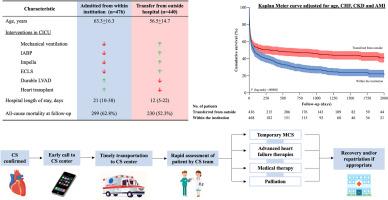Need for Support: Facilitating Early Transfer of Cardiogenic Shock Patients to Advanced Heart Failure Centres
IF 2.5
Q2 CARDIAC & CARDIOVASCULAR SYSTEMS
引用次数: 0
Abstract
Background
Cardiogenic shock (CS) is a complex, life-threatening condition that requires timely care of patients. The purpose of this study is to evaluate the characteristics and outcomes of patients transferred to a cardiac intensive-care unit from outside hospitals, compared to those of patients admitted directly to a CS centre.
Methods
Patients admitted with CS (January 1, 2014-December 31, 2019) were analyzed. Clinical characteristics and outcomes were recorded.
Results
A total of 916 patients were admitted with CS; 440 (48.0%) were transferred from outside hospitals, and 476 (52.0%) were admitted directly to our institution. Transferred patients were younger (56.5 ± 14.7 vs 63.3 ± 16.3 years, P < 0.001), required vasopressor support more often (63.6% vs 14.9%, P < 0.001), and required mechanical ventilation more often (40.6% vs 10.7%, P < 0.001) upon transfer to the cardiac intensive-care unit. Transferred patients more frequently required extracorporeal life support (8.9% vs 3.0%, P < 0.001), had a lower rate of requiring orthotopic heart transplantation (6.4% vs 14.6%, P < 0.001), and had a lower incidence of all-cause mortality during follow-up (52.3% vs 62.8%, P = 0.001). With a multivariate analysis, patients transferred from outside were found to be less likely to reach the composite endpoint of durable ventricular assist device, orthotopic heart transplantation, or death (hazard ratio 0.75, 95% confidence interval 0.62-0.90, P = 0.003).
Conclusions
Marked differences are present in the characteristics and outcomes of patients transferred from outside institutions vs of those transferred from within our quaternary-care centre. Further studies are required to evaluate decision-making for transfer of CS patients and assess CS outcomes in the setting of standardized CS protocols and interventions.

需要支持:促进心源性休克患者尽早转入高级心力衰竭中心
背景心源性休克(CS)是一种复杂的危及生命的疾病,需要对患者进行及时治疗。本研究的目的是评估从外院转入心脏重症监护病房的患者与直接入住心源性休克中心的患者的特征和治疗效果。结果 共收治了 916 例 CS 患者,其中 440 例(48.0%)从外院转入,476 例(52.0%)直接入住本院。转院患者的年龄更小(56.5 ± 14.7 岁 vs 63.3 ± 16.3 岁,P < 0.001),转入心脏重症监护室后需要血管加压支持的比例更高(63.6% vs 14.9%,P < 0.001),需要机械通气的比例更高(40.6% vs 10.7%,P < 0.001)。转院患者更经常需要体外生命支持(8.9% vs 3.0%,P < 0.001),需要心脏移植的比例较低(6.4% vs 14.6%,P < 0.001),随访期间全因死亡率较低(52.3% vs 62.8%,P = 0.001)。通过多变量分析发现,从外部转入的患者达到耐久性心室辅助装置、正位心脏移植或死亡综合终点的可能性较低(危险比为0.75,95%置信区间为0.62-0.90,P = 0.003)。需要进一步开展研究,评估转院 CS 患者的决策,并在标准化 CS 方案和干预措施的背景下评估 CS 的预后。
本文章由计算机程序翻译,如有差异,请以英文原文为准。
求助全文
约1分钟内获得全文
求助全文
来源期刊

CJC Open
Medicine-Cardiology and Cardiovascular Medicine
CiteScore
3.30
自引率
0.00%
发文量
143
审稿时长
60 days
 求助内容:
求助内容: 应助结果提醒方式:
应助结果提醒方式:


